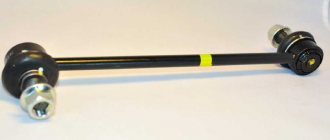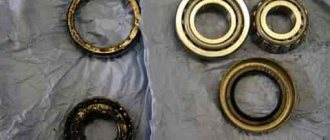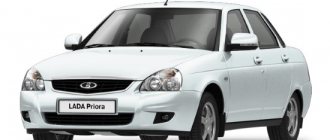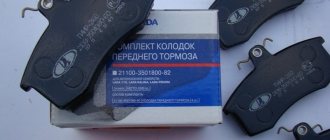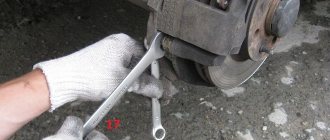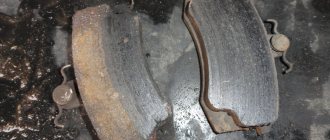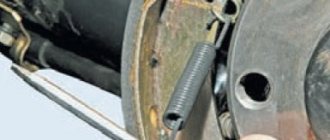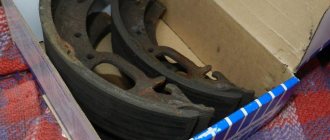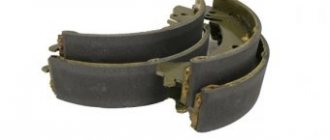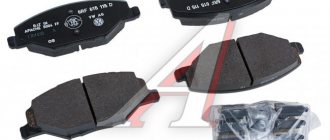Replacing the front brake pads of a Hyundai Solaris is necessary with the minimum permissible service life (gasket thickness). You can repair it at a service station or replace the parts yourself. The brake mechanism is simple and easily accessible, so there should be no problems with repairs.
After removing the wheel, disassembling the caliper and replacing parts is not difficult
When do you need to change the front brake pads on a Hyundai Solaris?
Hyundai Solaris does not have a limited mileage, after which replacement of the front pads is required. The disc brake mechanism is equipped with an acoustic indicator; if the service life is low, the device makes a grinding noise, which is a signal to replace the front brake pads. How long the mechanism on a Hyundai Solaris will last without repair depends on a number of factors:
- Weather. In damp climates, replacement will be more frequent than in dry climates.
- Driving manners. If you avoid sudden braking, do not leave the car on the handbrake for a long time and do not start driving without removing the handbrake, then the front pads will last for at least four years.
- Condition of the roads. If you have to brake sharply and often on a bumpy road, the wear will be faster.
Repair of front brakes is necessary in the following cases:
- when replacing a disk;
- in the presence of deep scratches and grooves;
- if there are separations of gaskets;
- the braking distance has been increased;
- there is a noticeable decrease in the efficiency of the maneuver, the car does not stop immediately;
- when a metallic black coating appears;
- When stopping suddenly, the car throws to the side; in winter, frequent uncontrollable drifts occur during emergency braking;
- The pedal sinks when pressed and vibration is felt;
- There is a knocking noise in the wheel when stopping suddenly.
Attention! Replacing front brake components is necessary if the thickness of the friction linings is at least 1.7 mm.
Time limits for repairs are difficult to determine. For extreme driving for drifting enthusiasts, repairs may be needed after 5 thousand km. For a neat average car enthusiast, the factory equipment will be enough for 20-25 thousand km.
How to check the condition of the brake disc?
As has already become clear, the most important indicator is thickness. It is this that determines how long the disk can last and when replacement will be required. On a Hyundai Solaris, like on any other car, you can carry out similar diagnostics yourself. To do this, just remove the wheel and check the wear. And then you need to look at the top edge of the disk.
If you want to obtain this knowledge in another way, then a caliper is best, which can measure the exact thickness of the disk and tell you whether replacement is needed. On Hyundai Solaris this parameter should be at least 20 mm. And then, this is the state when it’s too late to think, it’s time to act. Do not forget that thickness is a fundamental indicator, both on the front and rear discs.
It is worth understanding that the disks on the Hyundai Solaris have their own part number. When choosing, you need to trust only him. The article was written in the service book, and information is available both about the front and rear discs. Also, looking at the article number, you can easily find out the cost of front discs in any store in the city, and this is a big advantage for those who do not want to overpay.
It is also worth noting that both front discs need to be changed at once, both on the left and on the right. This rule appeared for a reason, it is completely justified and understandable to any person who can think logically and understands that if the wear on the left part is greater, then the left wheel will slow down longer. And this is a hundred percent skid. When purchasing, it is also important to focus on the article number, because it distinguishes a fake from the original Hyundai Solaris.
Which front pads to choose
It is better to opt for the original models 581011RA05 or 581014LA00, which are supplied as standard with the Hyundai Solaris. The following companies have proven themselves well:
- P18025 Brembo;
- Sangsin SP1400 and Brake SP1399;
- GDB3548 TRW;
- SANGSIN SP1399;
- 2534801 Textar;
- ESD7052 (Yes-Q);
- D11268MH KASHIYAMA
- Hankook FPH27 Frixa.
Important! Kits are purchased for two front wheels at once, regardless of whether the system on one of them is in good condition or not. Parts are changed at the same time.
If this is not done, the car will move to the side when braking.
Hyundai pads are equipped with a metal system for acoustic wear detection
Required Tools
Necessary equipment for replacing pads on Hyundai Solaris (2014, 2015, 2016, 2022, 2018):
- jack;
- balloon key;
- flat screwdriver (large);
- pliers;
- spanner or open-end wrench;
- metal brush;
- lubricant for calipers and pads, sealant for bolts.
A metal stopper under the rear wheels will come in handy (it can be replaced with a wooden, wedge-shaped beam). The device is necessary to fix the rear wheels so that the Hyundai Solaris does not roll when the body is jacked up.
How to change front brake pads on a Hyundai Solaris
At the beginning of dismantling the front brake mechanism, check the level of the fluid in the reservoir. If the indicator is at the maximum, it is removed using a syringe. After the repair is completed, the fluid is returned or a new one is added. Remove the cover and leave the reservoir open while replacing the pads.
The sequence of repairing the front brake mechanism on a Hyundai Solaris:
- Choose a flat area without slopes.
- Stoppers are installed under the rear wheels to prevent the car from rolling.
- A jack is placed under the frame and the body is raised. For insurance, they place, for example, a block of wood nearby, in case the car moves off the jack.
- Use a balloon wrench to unscrew the bolts and remove the wheel.
- Turn the steering wheel of the Hyundai Solaris all the way in the opposite direction from the front wheel on which the pads are being replaced.
- A screwdriver is inserted between the pad and the disc, the piston is moved apart and lowered to the limit so that it completely sinks into the cylinder.
- Using a 17 wrench, completely unscrew the lower and upper bolts on the guide fasteners.
- The caliper is disconnected and the part is fixed to the shock absorber strut.
- Remove the inner and outer blocks from the guide.
- Pry it up with a screwdriver and take out the plates.
Important! Pay attention to the piston: before installing new parts, it must be recessed inside the cylinder as much as possible; for this you will need sliding pliers.
Use a metal brush to clean the surface from dirt and oxidation, paying special attention to the planting niches.
If the protective covers on the guide pins are damaged, they need to be replaced with new ones.
Pay attention to the wear of the pads: it should be approximately the same. If one gasket is almost new, and the second is completely worn out, repair or replacement of the caliper is necessary.
After dismantling, reassemble the brake mechanism in reverse order, first coating the inside of the parts with lubricant.
After collection, the front wheel is returned to its place, and the lifting and body-fixing device is removed. Fill the reservoir with brake fluid and screw on the cap. After replacing the pads on both front wheels, press the pedal several times so that the distance between the parts of the mechanism returns to normal.
The first time after replacement, use the brakes carefully; it is necessary for the parts to get used to it, so sudden braking is undesirable. Check the condition of the mechanism during seasonal tire changes. Once every 2 years, the front system of the Hyundai Solaris is diagnosed at a service station.
How does pad wear manifest itself?
Koreans, like most modern cars, have a special wear sensor, only if the warning light comes on on most cars, the Koreans used nanotechnology and installed a metal squeak.
The principle of operation is that when the pads are heavily worn, this part is pressed against the disc and creaks disgustingly. She looks like this:
No, the pads are still there and the car can be driven for a few more weeks! But if you ignore replacing the pads, over time you will also have to change the brake discs! Therefore, if on a Solaris, when braking, you hear a squeaking sound, it’s time to change the pads!
Replacing brake pads on Hyundai Solaris
Attention! Be sure to check the brake fluid level in the barrel; if the fluid level is in the area of the MAX scale, pump out the fluid using a syringe or rubber bulb, and get to work.
Replacing front brake pads
To replace the front brake pads on a Hyundai Solaris, we will need the following tool:
- key for 14.
- High quality flat head screwdriver.
- sliding pliers for bringing the brake cylinders together (although it is possible without them).
- metal brush (brush).
- wheel wrench (wrench for removing a wheel).
- wire (to tie the removed calipers to the springs and not damage the hoses)
Consumables:
- The pads themselves are 58101-4LA00, but there are many high-quality analogues at a price 2 times lower!
- wd40
Step-by-step instructions for replacing front pads:
Use a screwdriver to separate the brake pads.
Using a 14mm wrench, unscrew the two caliper mounting bolts (it’s better to start with the bottom one).
We tie the caliper to the spring, so it does not interfere and there is no chance of damaging the hose.
We remove the old pads from the guides
We remove the guides and clean them using a cork. brushes.
We install new pads.
- Using sliding pliers, we recess the piston into the cylinder (if you have not pumped out the excess liquid, it may pour out through the top of the barrel)
- We install the caliper in place, screw it on and install the wheel.
- Here's a picture of old and new pads for comparison:
Replacing rear brake pads
The tool does not change, everything is the same as for the front brakes.
Consumables:
- the pads themselves (58302-1RA30), but there are many high-quality analogues at a price 2 times lower!
- wd40
Step-by-step instructions for replacing rear pads:
- We install wheel chocks under the wheels, tear off the wheel nuts, remove the car from the handbrake, jack it up, and remove the rear wheel.
- Using a screwdriver, we bring the pads together.
- Unscrew the caliper and move it to the side.
Remove the fixing plates and clean them with a brush.
- We replace the pads with new ones.
- Using pliers, we press down the brake cylinder (many people do this with a 17 mm wrench or rotating the piston with pliers)
- We install the brake caliper in place, screw it on
- Put on the wheel, lower the jack
- If necessary, adjust the handbrake (this is done from inside).
Conclusion
If you don’t want to get your hands dirty, you can contact the nearest car service center; replacing brake pads is not expensive and can be done in 30 minutes. By the way, for large cities, there is an excellent service - Remontista, which allows you to choose a car service, based on price and location, without leaving your chair.
That's all for me today! I hope that after reading the article, replacing the pads on a Hyundai Solaris will not cause you any difficulties.
Source: https://life-with-cars.ru/remont-v-garazhe/hodovaya-chast/samostoyatelnaya-zamena-tormoznyh-kolodok-na-hendaj-solyaris-hyundai-solaris/
Errors when replacing pads
To ensure effective front pad replacement, common mistakes should be avoided.
After assembling the mechanism, you should not immediately drive onto a busy road for testing. The need for constant hard braking will impair the performance of new front parts that have not yet broken in.
When replacing, you need to pay attention to the disk. It is also subject to wear and tear. If the surface is worn out, then replacing parts will not improve the efficiency of the mechanism; in this case, the front disc will need to be reinstalled.
It is recommended to avoid sharp braking on the Hyundai Solaris for the first 100-200 km; the undeveloped surface of the parts becomes very hot and begins to burn, which reduces the efficiency of the maneuver and shortens the wear period.
When to change?
You may be interested in: DIY ATV frame - tips and assembly features
The manufacturer does not provide clear regulations on the time frame for replacing the front brake pads on the front wheels. The driver must monitor their wear himself. But the pads must be changed if the disc has been replaced, oil has gotten on the friction linings, deep grooves have appeared on the working surface as a result of use, cracks, chips. Also, replacement of brake pads on Hyundai Solaris is carried out in the event of separation of the friction linings from the metal base of the pad. In practice, the average time from replacement to replacement for front wheels is 30 thousand kilometers. Rear drum pads have twice the service life. However, the rate of wear depends on a variety of factors.
You may be interested in: The whole truth about tire pressure in Skoda Octavia
The inner pads have an acoustic wear indicator. During braking, a characteristic grinding noise is heard. This means that the pad is worn to the limit. The front pads on this car model can only be replaced as a set. If you replace a pair of pads on only one side, the car may pull to the side during braking.
Replacing clutch discs Hyundai Solaris
Is it possible to replace the clutch disc yourself if it wears out? The service life of the part depends on many factors: operating conditions and driving style, the driver’s tendency to abruptly change gears.
The difficulty of repair and replacement is that the conditions of a lift or overpass are required. And in winter, such work can only be carried out indoors (garage, auto repair shop). Keep in mind that when changing a disc, experts recommend replacing the clutch basket with a new one.
The replacement will take at least 6 hours and is carried out according to the following algorithm:
- instruments are prepared;
- the machine is placed on a lift - an overpass or inspection pit;
- the motor is hung out;
- the axle shafts are disconnected;
- the gearbox is completely removed, for this you will first need to empty it of used oil;
- the starter is removed;
- the subframe is removed;
- the steering rack is removed;
- The technical condition of the bearing fork is checked. This must be done at every service, but will also need to be repeated when replacing clutch discs;
- the clutch is dismantled. To do this, use a 12mm wrench to unscrew the 6 screws securing it to the flywheel, all its parts are checked for mechanical damage and other defects, defective elements should be replaced;
- the pressure (basket) and driven disks are removed;
- new parts are installed in reverse order;
- bolts are tightened;
- all parts of the car structure are returned to their place.
As you can see, the task of do-it-yourself replacement is accessible only to experienced car enthusiasts or professionals, but it will help maintain the performance and reliability of the car for a long period.
Reasons for accelerated wear
The rate of wear is most often influenced by two factors. The first is illiterate operation of the brake system. Considering the fact that the Hyundai Solaris is equipped with a relatively powerful engine, most drivers prefer a more aggressive driving style. Sharp acceleration forces the driver to press the brake pedal more often. Aggressive driving leads to faster pad wear. Also, most modern drivers have no idea about engine braking, but this technique allows you to increase the time for replacing brake pads on a Hyundai Solaris by two or more times.
The second factor is an attempt to save money and the installation of cheap pads, where inappropriate materials were used for the production of friction linings. Such pads have a shorter service life. In addition, due to low-quality linings, discs and drums wear out faster.
How do you know when it's time to make a replacement?
A novice driver can understand that the brake pads on a Hyundai Solaris need to be replaced by the following signs. If a car is equipped with a set of alloy wheels along with disc brakes, then the condition of the pads can be conveniently observed through the slots in the discs. The wear will be clearly visible. Another simple option is wear sensors or indicators. They are electronic and mechanical. If an electronic sensor is installed, the corresponding light on the instrument panel will light up.
You can determine pad wear by checking the brake fluid level. If there are no leaks in the system, and the fluid level in the expansion tank has dropped, this may be caused by worn pads. The piston stroke is increased due to thinner pads, so the level drops.
Also, worn out pads will be indicated by a vibration in the steering wheel when braking. This occurs due to deformation of the pads or discs. If, when accelerating to 80 kilometers per hour and sharp braking, the car pulls to the side and you feel a beating on the brake pedal, then you need to replace the brake pads and discs with Hyundai Solaris ones. Don't hesitate on this.
Brake system maintenance is mandatory
The need for replacement is due to several reasons, one of the main ones being the minimum thickness of the brake discs. When there is a lot of wear, the volume of metal is not enough to effectively distribute the heat that occurs during prolonged braking. Deformation and, as a consequence, beating may occur. Which is especially noticeable when braking.
If the wear of the front discs exceeds 2 mm, then this is a signal for replacement. The thickness of the new brake discs is 22 mm. The rear discs are different in thickness from the front ones. Their thickness is 10 mm, and the permissible thickness is 8.4 mm.
To determine brake disc wear, use an electronic caliper and measure the thickness in different areas of the disc. Using the average value, determine how worn it is.
The service life of the products is 55-70 thousand kilometers. This is not regulated in the technical documentation, but, as practice shows, it is at this mileage that critical wear appears.
Signs may appear earlier indicating that the disks are at the end of their useful life.
Step-by-step instructions for replacing front pads
Let's see how to change the front pads with your own hands in the garage using a set of standard tools. The first step is to remove the wheels. Then you need to insert a flat-head screwdriver with a wide blade into the window in the caliper between the pads and the disc. In this way, the brake pads are spread and the piston is recessed into the cylinder. Next, use a 14mm wrench to unscrew the bolts securing the caliper to the pin. The caliper is then removed from the guides. There is no need to disconnect the brake hose. The caliper is tied to the spring. Next, remove the outer block from the guide, and pull out the inner block in the same way. Using a screwdriver, remove the guide plates.
Next, you should install new pads, but before that you need to press the piston into the cylinder as much as possible. This is how the front brake pads are replaced on a Hyundai Solaris. This procedure can be done with your own hands in an hour.
Rear pads
First you need to remove the rear wheel and use a 14 mm wrench to unscrew the bolt securing the caliper to the pin. The same operation is performed with the second bolt. The caliper is carefully removed from its guides, being careful not to damage the brake hose and handbrake cable. Using a screwdriver, carefully move the block along the plates and remove the outer block, and then the inner one. Next, the screwdriver is installed in the resulting gap between the pad guide and the plate. By squeezing the plate, it is removed from the guide. Before installing new pads, the piston must be recessed into the cylinder. This can be done using a handy tool.
When the pads are removed, there is no need to press the brake pedal. The piston may be completely out of the brake cylinder. This is how to replace the rear brake pads on a Hyundai Solaris. At the rear, as well as at the front, a disc brake mechanism is installed.
Differences in replacement times for front and rear pads
Most modern cars have disc brakes at the front and drum brakes at the rear. Rear drum brakes have a longer service life than disc brakes. This is due to their design features - less dirt and dust gets into closed drums, the contact area of the pads with the braking surface is higher than that of discs, and also because they experience less load during the braking process.
This leads to the conclusion that the rear and front pads are changed at different times, independently of each other.
Replacing front brake pads
- The first step is to put the car on the parking brake, and then install the wheel chocks.
- Now you need to slightly loosen the wheel nuts.
- Next, you need to lift and install the supports under the rear hubs, after which you can unscrew the fastening nuts and remove the wheels.
- The next step is to unscrew the bracket fastening bolts, while holding the fingers with a special wrench to prevent them from turning.
- On the brake caliper, the movable caliper must be removed.
- Next, start hanging the bracket on a wire or rope to the front suspension parts. When carrying out this work, pay attention to the condition of the brake hose; it is important that it is not twisted or stretched too much.
- Now carefully remove the outer and inner brake pads from the guide.
- Check the condition of the protective covers; their rubber should not be damaged.
- Press in the piston using pliers. Be extremely careful not to damage the piston boot.
- Install the plates in reverse order. It is advisable to lubricate the threads of the caliper pins with a special anaerobic thread locker in order to prevent the bolts from unscrewing.
- Press the brake pedal several times at regular intervals to remove any gaps in the brake mechanism.
- Reinstall the wheel. Use the same principle to replace the pads of the other wheel.
Replacing rear brake pads
Be sure to check the markings of your brake pads so that you can purchase new ones with the same markings. Brake pads must be replaced as a complete set - 4 pieces.
When replacing pads, it is recommended to check the condition of the rubber protective covers of the guide pins. Also, it is worth checking the ease of movement of the caliper relative to the brake pad guide.
If it is difficult to mix, then you need to lubricate the caliper guide pin with grease.
To replace the rear wheel disc brake pads, do the following:
- Put the car in gear. If you have an automatic, then move it to position P. Install anti-stop shoes under the front wheels.
- Raise the rear of the car on supports. Unscrew the mounting bolts and remove the wheel.
- Remove the upper and lower bolts of the caliper guide pins, holding the pins from turning with a second wrench.
- Remove the movable bracket from the disc, but do not disconnect the brake hose.
- Remove the inner and outer pads from the guide.
- Then pry it up with a screwdriver and remove the retaining plates of the upper and lower guide pads.
- Press in the piston using pliers. Be extremely careful not to damage the piston boot.
- Install the plates in reverse order. It is advisable to lubricate the threads of the caliper pins with a special anaerobic thread locker in order to prevent the bolts from unscrewing.
- Press the brake pedal several times at regular intervals to remove any gaps in the brake mechanism.
- Reinstall the wheel. Use the same principle to replace the pads of the other wheel.
- Check the brake fluid level. If necessary, top it up.
Replacing front brake pads
Technology for replacing front brake pads on Hyundai Solaris:
- jack up the body (or use a lift), remove the wheel
- Using a screwdriver with a wide blade, we spread the pads and press the brake piston deep into the cylinder
- then unscrew the upper and lower bolts that secure the caliper
- Without disconnecting the brake hose, remove the brake caliper from the guides
- then you can tie the caliper to the shock absorber or spring so as not to tear the hose
- remove the brake pads from the guides,
- remove the lower and upper guide plates of the pads
- check the condition of the caliper boots and replace them if necessary
- recess the piston as deep as possible into the cylinder
- clean the seats and guides
- put the brakes back together in exactly the same order
-6-12-03-11
To do this, use sliding pliers to press the piston into the cylinder, being careful not to damage the boot.
Before installation, we clean the brake mechanism parts from dirt and corrosion, especially the brake pad seats in the caliper guide plates and the pad guide.
It is prohibited to use gasoline and diesel fuel to clean brake mechanisms.
If the protective covers of the guide pins are torn, replace them with new ones.
We assemble the brake mechanism in reverse order.
After replacing the pads on both front wheels, press the brake pedal several times to set the gaps between the pads and discs.
[We save up to 5,000 rubles on Hyundai Solaris maintenance] [Hyundai Solaris maintenance for 15 thousand kilometers] [Hyundai Solaris maintenance for 45 thousand kilometers] [Hyundai Solaris maintenance for 60 thousand kilometers] [Do it yourself Maintenance - general recommendations] [Safety rules for carrying out vehicle maintenance yourself] [ Tools required for maintenance of Hyundai Solaris]
Replacing the brake pads of the front wheels of Hyundai Solaris
Inspection of pads at a service station or yourself
For inspection, you will need to remove the corresponding wheel. Those. you need a jack or lift (pit). You will also need a caliper and a ruler to measure the remaining friction layer.
Typically, the minimum permissible thickness of the residual layer is 1.5 - 2 mm.
A brake disc with deep grooves also indicates severe wear. For discs, the minimum permissible thickness is 10-12 mm.
The wear of the brake pads in the rear brake drums is determined through a special inspection hole in the drum body; if there is none, then you will have to remove the entire brake drum and use a ruler or caliper to measure the remaining thickness of the friction layer. Indirectly, the condition of the rear pads is related to the handbrake, when it stops holding or operates on the last click - this indicates increased wear.
Features of replacing rear pads
The rear calipers have design features despite the fact that, like the front ones, they are disc brakes. In order to recess the brake piston in the rear caliper to its initial position, the use of a special tool is required. The brake piston returns to its initial position, rotating around its axis. To do this, you need to press the piston and also screw it clockwise at the same time.
For more convenient access to the piston, you need to unscrew both guide bolts. If you don’t have a puller, then try using a handy tool, such as pliers, to turn it. You also need a device to simultaneously press the piston. Do not rush to dismantle the unit by disconnecting it from the pipelines. In this case, you will have to bleed the brake system to remove air.
Wheel stud repair: features
This indicator is a guideline when it is necessary to change brake discs. You can calculate the number of kilometers traveled and approximately find out the replacement period. The lifespan of parts is designed for 100-150 thousand kilometers, but in reality the Hyundai Solaris has much less.
When the disc and pad are severely worn, the brake cylinders reach their maximum length. As a result, their mirror surface is constantly exposed to moisture. This leads to premature rust. If you install new Hyundai Solaris brake discs on rusted cylinders, the likelihood that there will be a lack of tightness is very high. The caliper assemblies may need to be replaced.
You should not operate the car to the extreme thickness of the brake discs. It would be wiser to replace them in advance. Better yet, install new discs and brake pads at the same time. In this case, they will quickly rub in and brake effectively.
Choose original parts from branded companies. Preferably those that specialize in the manufacture of consumables exclusively for the brake system. Each driver has his own answer to how long brake discs last. It depends on your driving style. But original parts will last many times longer than those made under license.
Deformation of the stud becomes the reason for its removal and replacement, otherwise the driving performance of the wheel will decrease.
Pad selection
The choice of brake elements on the Hyundai Solaris is quite difficult. Many analogue manufacturers offer a wide range of parts, which confuses the average owner. As mentioned earlier, the pads and disc brakes on the Hyundai Solaris differ depending on the engine size. In our case, for Solaris the front ones have the original number -581014LA00. The average cost is 5,500 rubles per set.
Install the wheel. Install the cap. Screw the wheel.
Dealers and the manufacturer recommend installing only the original, but what to do when you don’t have enough money for it. A person begins to look for ways to save money and finds a number of analogues, from a cheap option to expensive spare parts. Let's look at what kind of brake pads there are on Hyundai Solaris
| Name | Catalog number | List of analogues |
| BM-Motorsport | FD 6001 | 1000 |
| Toko | T2103027L | 1100 |
| Mando | MPH46 | 1100 |
| Hsb | HP0047 | 1100 |
| Nipparts | N3600550 | 1100 |
| Profit | 5000-0625 | 1200 |
| Febest | 1201-SBF | 1500 |
| Finwhale | V1017 | 1500 |
| Japan Parts | PA-K24AF | 1500 |
| Denckermann | B111324 | 1500 |
| Fenox | BP43151 | 1600 |
| Bremsi | BP3470 | 1700 |
| Valeo | 301021 | 1700 |
| Meyle | 025 253 4818 | 1700 |
Factory recommendations
As always, the manufacturer recommends replacing pads only at a branded or dealer service station. Our man, having listened to everything and found out the price, decides that he needs to save money and replace them himself. Of course, sometimes garage repair difficulties arise, but this is not a frequent occurrence and everything, as a rule, is resolved very quickly.
What's suitable
The table shows the manufacturers of popular brake discs for Solaris 2:
| Manufacturer | Item number |
| AMD | BD272 |
| ASHIKA | 600KK18 |
| Bosch | 0986479367 |
| JAPKO | 60K18 |
| NIBK | RN1956 |
| TEXTAR | 178949 |
| Zimmermann | 320380320 ( rear discs – last three digits 352) |
When else is it necessary to replace?
The maximum allowable wear is not the only situation when it is time to think about replacement. Other cases when a car owner will need to do this:
- it was necessary to replace the brake system discs - they are changed along with the pads;
- the linings are oily or cracked, chipped or deep grooves appear on them;
- The pads and linings themselves began to peel off from each other.
Inspections will not be required too often. The Korean manufacturer has equipped the Solaris model pads with convenient acoustic indicators. Thanks to these devices, the car owner will definitely not miss the moment when parts are approaching extreme wear.
Acoustic indicators simplify car diagnostics, which is especially important in urban environments, where you constantly have to brake sharply. When the pads are worn out, a characteristic grinding noise is heard when braking. Having heard it, you should take note of this, be sure to inspect the brake system at the next opportunity and replace the components with new ones.
Wear and consequences
A brake disc, like other car parts, has a limited service life. Manufacturers tentatively indicate this parameter in the vehicle documentation.
Objective correlation depends on the following factors:
- car mileage;
- driving style;
- the condition of the road surface on which cars most often drive;
- passenger and luggage load or lack thereof;
- features and quality indicators of installed elements.
Example of a worn disk
Choosing which brake pads are best for Hyundai Solaris
Last year I bought a Hyundai Solaris, a popular car in Russia. And its popularity lies in its simplicity, reliability and inexpensive maintenance. The process of servicing the Solaris brake system is very simple: monitoring the wear of brake discs, replacing the front and rear pads.
These are all simple operations that anyone can do with their own hands. But choosing which consumables to use is more difficult, since there are a huge number of brands and it’s easy to buy something of poor quality.
What types of pads are there?
In short, any pad, regardless of brand, can be one of four types:
- Ceramic pad. The most expensive, the toughest, the most silent, the lightest. They are made from ceramic fibers, they generate virtually no dust and wear out the brake disc.
- Semi-metallic block . The composition is half metal, it can be copper powder, graphite or iron powder. Their disadvantage is that they do not tolerate frost and can be quite noisy. The resource is not very high.
- Organic block . Consist of rubber, glass and polymer fibers. Quiet and soft pads practically do not wear out the brake disc, but quickly wear out themselves.
- Low metal block . About 20-25% of hard steel or copper is added to the organic composition. This improves heat transfer and extends the service life. Excellent frictional properties, but can be noisy and generate dust.
- Since Solaris is far from a sports car, expensive ceramic pads would not be appropriate here.
From a cost perspective, it doesn't really matter how hard the brake pads are - if they are soft, frequent replacement will be necessary, but you can save on expensive discs. If the pads are hard, then they are changed less often, but the disc wears out more intensively. It all depends on your driving style.
The best choice is the original pads (Mobis/Sangsin)
- Original Mobis pads, which are installed from the assembly line. Catalog number 58101-1RA05 for the front ones, 58302-1RA30 for the rear ones. The cost is approximately 2500 rudders. They are sold complete with brackets, but for the aftermarket they are marketed under the Sangsin brand.
What material are the pads made of?
All types of brake pads are the same in design: they are a metal plate with a friction coating applied to the surface. The composition can vary greatly, so the main varieties are distinguished:
- The friction layer consists of a metal, most often copper, mesh and graphite filling. Such semi-metallic pads have good heat dissipation, but are noisy and wear out quickly.
- The metal content in the coating is less than 30%, the rest is made up of organic fillers (glass, graphite, Kevlar). More efficient and less noisy.
- Made entirely of composite materials, they have good braking properties and are silent, but their service life will be even shorter.
- Fully ceramic pads are made of mineral fibers sintered together with filler and a small amount of copper. The lightest, most effective and durable, but also the most expensive.
